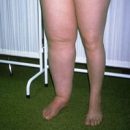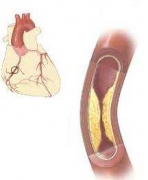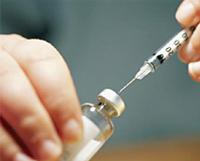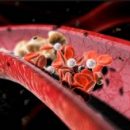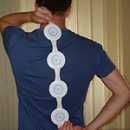Manual lymphatic drainage is of particular importance in the treatment of lymphidem, since it not only supports the circulation of lymph, but also contributes to the outflow of fluid from tissues. Pneumatic massage is the method of intermittent compression and is considered an additional therapeutic event.
Content
The value of manual lymphodroenaga
Manual lymphodenage in the complex treatment of the lymphedem has a special, and even exceptional importance. The goal of the manual lymphatic drainage is primarily supporting and strengthening the drainage function of lymphatic vessels, that is, the acceleration of the outflow of lymph, as well as the strengthening of the transport function of the lymphatic system. Manual lymphodrenage not only supports the circulation of lymphs in vessels, but also assigns its clusters from soft tissues.
Types of manual lymphodroenazh
Manual lymphatic drainage should be carried out only by a specialist, daily within 1 hour. The duration of the massage rate is an average of up to 20 days. Manual lymphatic laminate can be divided into:
- transport
- absorption
«Transport» Massage is intended to remove clusters of lymphs from soft tissues. It always begins in proximal (i.e.), and not in the distal parts of the hand, as it is often mistakenly done, so first it is necessary to release the proximal region of the lymphatic channel for the free outflow of lymphs from distal (long) departments of the upper limb. Massage movements must accurately go along lymphatic vessels.
Absorption massage is characterized by rhythmic squeezing of the hand across the circumference with the help of light movements of the fingers and palm of the masseur. Massage begins in the proximal (neighbor) parts of the hand, affected by the lymphedema, and moves in the distal direction (that is, towards the fingertips). At the same time, there is a disappearance of the changed fluid tissue of the hand. The strength and pressure of massage movements should not lead to a violation of fragile lymphatic capillaries and to their constant compression, and thereby blockade that violates the function of the lymphatic pump.
Pneummassazha
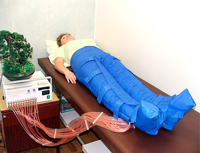 Pneumatic massage is a method of intermittent compression (compression) and refers to additional therapeutic measures used in the complex treatment of lymphedem. This procedure is carried out with the help of special devices for intermittent pneumocompression of the APKU-5 type, «Flowpac», «Flowtroii», «Flowpress» and others. Pneumatic massage is carried out as follows - the hand lays into an inflatable cuff, which is further filled with air under pressure. This pressure is transmitted to the upper limb, due to which the stagnant lymph is extruded from the brush to the shoulder.
Pneumatic massage is a method of intermittent compression (compression) and refers to additional therapeutic measures used in the complex treatment of lymphedem. This procedure is carried out with the help of special devices for intermittent pneumocompression of the APKU-5 type, «Flowpac», «Flowtroii», «Flowpress» and others. Pneumatic massage is carried out as follows - the hand lays into an inflatable cuff, which is further filled with air under pressure. This pressure is transmitted to the upper limb, due to which the stagnant lymph is extruded from the brush to the shoulder.
Pumping systems for pneumatic devices exist both single-chamber and multi-chamber. During the use of a multi-chamber cuff at first, the cuff camera is inflated, the most distant from the torso, and then alternately filled with air the following cameras, which are closer to the body. The procedure for this massage resembles «Issue» Soft fabric lymphs. At the same time, it is very undesirable that the edema fluid, moved from remote finiges to its base, was struck there. This is due to the fact that the stagnant protein dissolved in the lymph causes secondary changes in tissues, the deteriorating state of the patient, and with time, at the base of the limb, the tissue seal develops.
Compression bandage
Compression bandage is used as an integral part of the complex treatment of lymphedems and is carried out after a manual lymphatic session. Studies show that with proper imposition of such a dressing, the blood flow of blood suffers slightly and the nutrition of the tissues of the hand does not violate. The volume of blood at the venous section becomes less, the lumen of the veins decreases, resulting in the rate of blood flow, and thus the prevention of thrombosis is achieved. Compression bandage is special bandages, with the help of which adequate squeezing of soft tissues of hand is achieved, and, accordingly, lymphatic and blood capillaries. This leads to the prevention of the stagnation of lymph and excessive blood flow in the tissue.
Another odinal positive effect of compression banding is to reduce the permeability of the capillar walls for plasma proteins, as a result of which the protein load on lymph is reduced. In addition, compression bandages also contribute to improved Lymph outflow.
Contraindication to the use of a compression bandage is the presence of signs of impaired blood flow (for example, a disease or Rhino syndrome, diabetes and T.D.).
There are three types of bandage bandages: low-elastic bandages, stretching maximum to 70%, and average elestant bandages, stretching by 70-140%, highly elastic bandages stretching more than 140%.
In the treatment of lymphedhem, bandages are only low and medium elasticity. The highly elastic bandage due to the reinforced return of rubber threads provides high pressure at rest and small working pressure, which has a low effect when exposed to microcirculation. Low elastic bandage provides low pressure at rest and high working pressure. This means that in the rest of the bandage is small, and during exercise it increases and squeezes the microcirculatory.
When you embed a bandage, you need to use soft gaskets in order to avoid excessive compression of protruding parts of the limb. As soft gaskets, you can use a foam thickness of 0.5-1.0 cm. To avoid irritation of the skin, friction bandages about the wound surface and a possible allergic reaction, before overlaying the dressing on the hand, the sleeve of cotton fabric is worn. It serves to absorb sweat.
For proper imposition of the dressing, it is necessary to achieve the most uniform tension of the elastic bandage. The direction of the binting of fundamental importance does not have if the bandage stretches uniformly, without the formation of pockets and transverse folds.

